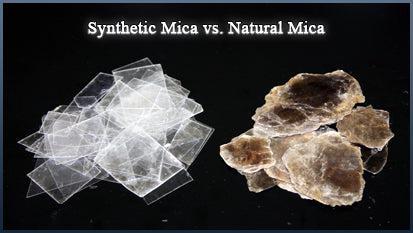
What is Mica? Is it Natural?
Share
There seems to be a lot of confusion about what mica is. A lot of people will tell you that all mica used in cosmetics is lab-made. The reasons given will be it’s lab made for purity, or it’s cheaper to make it in a lab. Both are incorrect.
Micas used in cosmetics can be naturally mined or they can be lab-made synthetics. Most of the micas we use in cosmetics and soaps are naturally mined micas, but synthetics are available. Naturally mined micas are less expensive, while synthetic mica – also called fluorphlogopite – is more expensive.
Here is a picture of natural vs. synthetic mica:

Synthetic mica is superior to natural mica in several ways. They are more pure, much more bright, and have superior clarity of color. We love synthetic mica!
Another question often asked is if naturally mined mica colors are natural. They are natural in their raw uncolored state. Natural mica is usually an off-white mineral and can have brownish tones. To achieve a bright color pigment is applied to the mica substrate using heat. Micas can be colored using various dyes and pigments to achieve the desired color. These colors are lab-made and are not natural. They are often made to be nature-identical.
The reason the colors used to pigment the mica are lab-made is primarily to achieve a certain level of purity. This is a good thing! The FDA has certain standards that color additives must meet:
Specifications. [Cosmetic] Mica shall conform to the following specifications and shall be free from impurities other than those named to the extent that such other impurities may be avoided by good manufacturing practice:
- Fineness, 100 percent shall pass through a 100-mesh sieve.
- Loss on ignition at 600-650 deg. C, not more than 2 percent.
- Lead (as Pb), not more than 20 parts per million.
- Arsenic (as As), not more than 3 parts per million.
- Mercury (as Hg), not more than 1 part per million. 21CFR73.1496
Basically, lab-created pigments are used to color cosmetic micas because they meet purity standards set forth by the FDA.
The FDA defines natural mica as:
The color additive mica is a white powder obtained from the naturally occurring mineral, muscovite mica, consisting predominantly of a potassium aluminum silicate, K2Al4(Al2Si6O20)(OH)4 or, alternatively, H2KAl3(SiO4)3. Mica may be identified and semiquantitatively determined by its characteristic X-ray diffraction pattern and by its optical properties. 21CFR73.1496
However, there is no definition or regulation for synthetic mica at this time! This does not mean that we can have a free-for-all with it. Synthetic mica must still contain FDA approved color additives to be considered cosmetic grade. There are some benefits to this, however. Because synthetic mica is not regulated by itself as a color additive, we can have more variance in micron size and mica use in cosmetics.
Naturally mined mica is not approved for use in cosmetics at a micron size higher than 150. Synthetic micas may be used in cosmetics at any micron size, since there are no regulations as of yet set forth by the FDA. YAY!
Hopefully this helps clear up some confusion about what kind of mica we use in soap and cosmetics, as well as the different types available.





